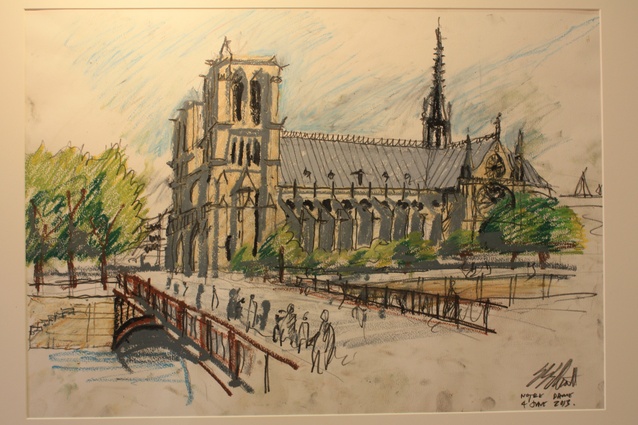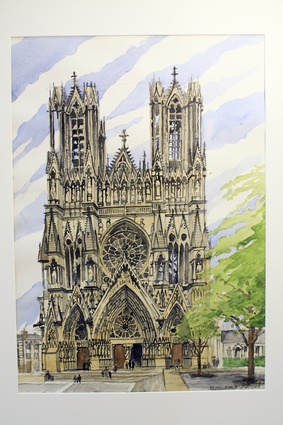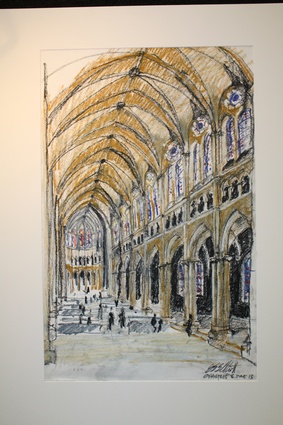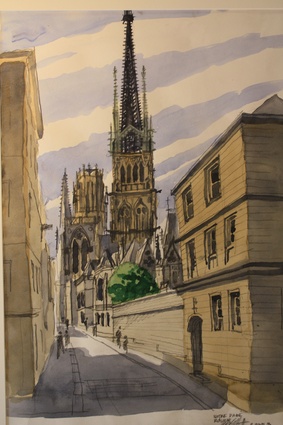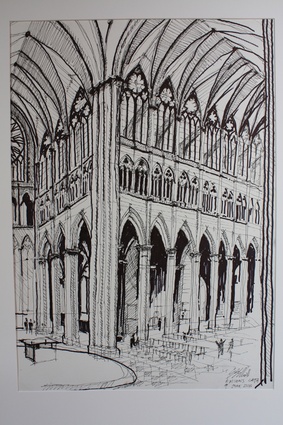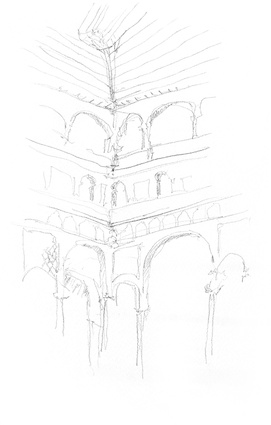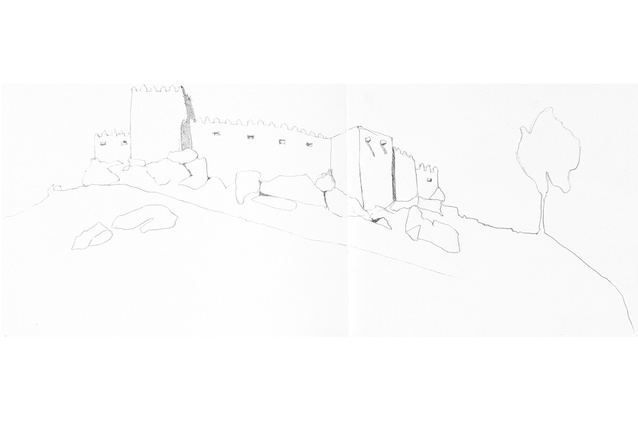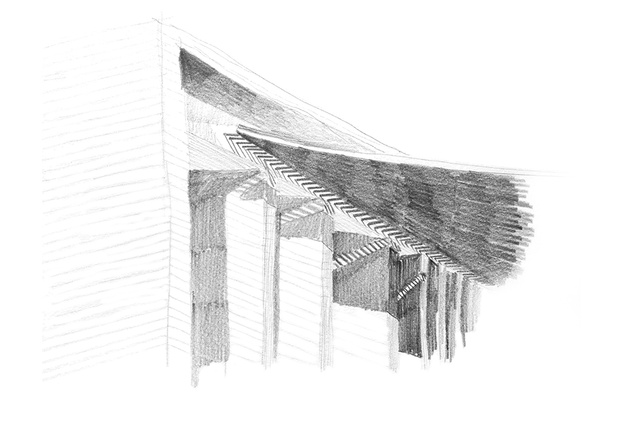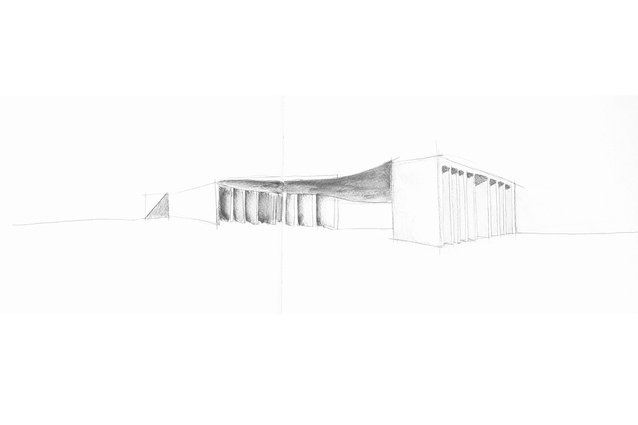Summer series #2: Grand Tour drawings
Throughout history, architects have sketched and painted their way around the globe to try and understand other architects’ buildings. Here, in the second of our Grand Tour summer series, we showcase the sketches of New Zealand architect Edwin Elliott from Elliott Architects and designer Erica Kenny from Erica Kenny Design, made while touring Europe at different times.
EDWIN ELLIOTT
Where was this drawing/sketch made and why this site?
All of these sketches were made in France, in the grand circle of cathedral cities radiating out from Paris. The sites were specifically chosen as they constitute most of the French gothic cathedrals in the development of high gothic. My friend Lou Alfeld and I chose to do an architectural drawing study of these, as a way to experience the buildings and places but also to simply paint and draw and experience the building through that medium.
Reims Cathedral
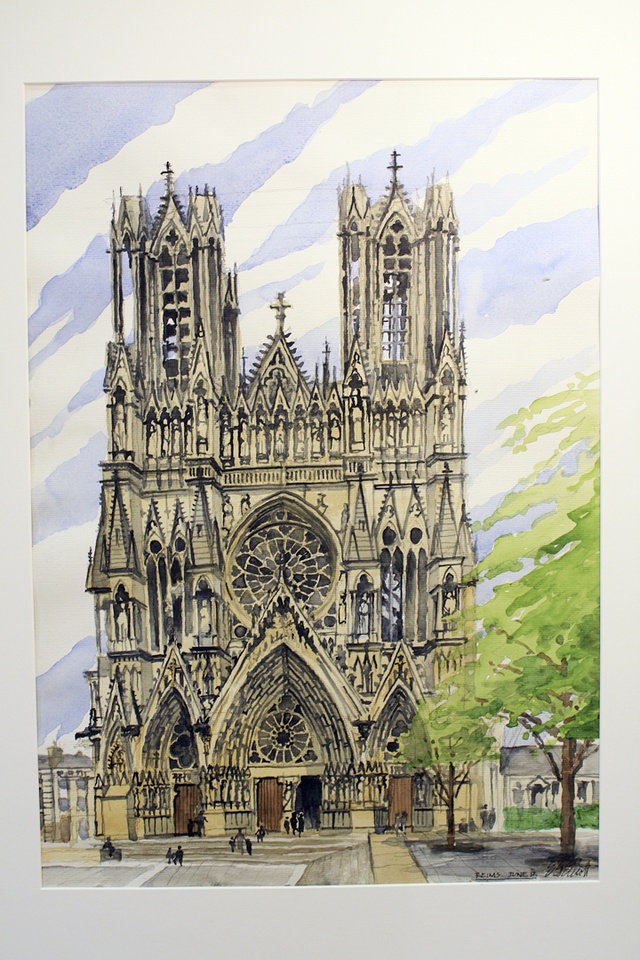
- Built from 1140 –1168, the Reims Cathedral is where all the French kings were crowned. Reims is in western France.
- This watercolour of the main façade took 9 hours in total on the same day. Reims has a very harmonious façade and hence the greater time taken on this one.
- Time was spent in courtyard till it started raining then several hours in the main apse and also time spent in a café working on it.
- Used an Iphone picture for reference so I could move to different locations and still progress.
Chartres Cathedral
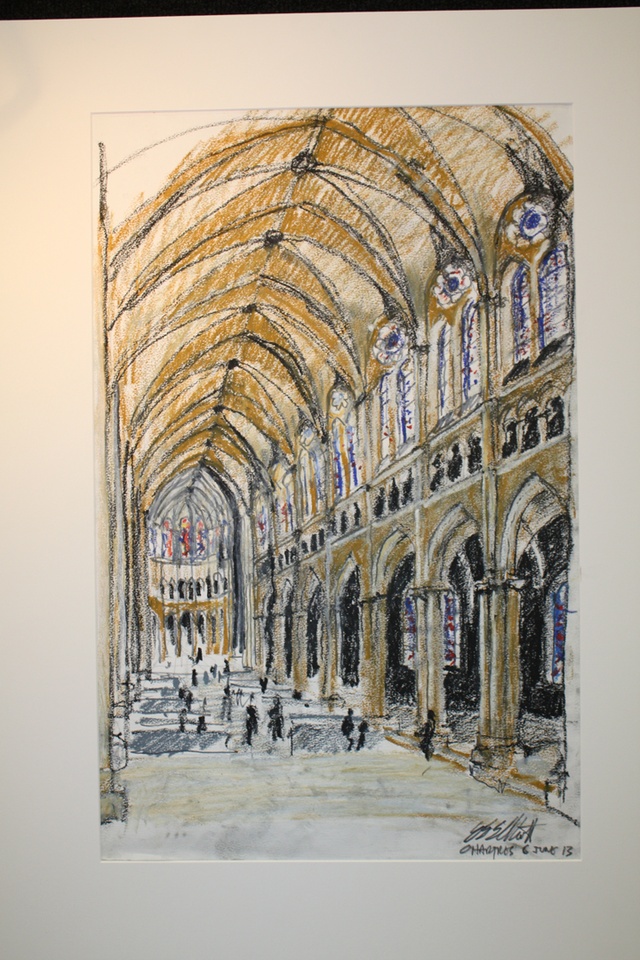
- Chartres is west of Paris. This magnificent early cathedral was built from 1100 to late 1500 in various sections.
- I drew this sitting in the main nave, just inside the entrance, with wonderful light illuminating the amazing but dark space.
- This was a pastel and 6b pencil drawing. It took one hour.
Rouen Cathedral
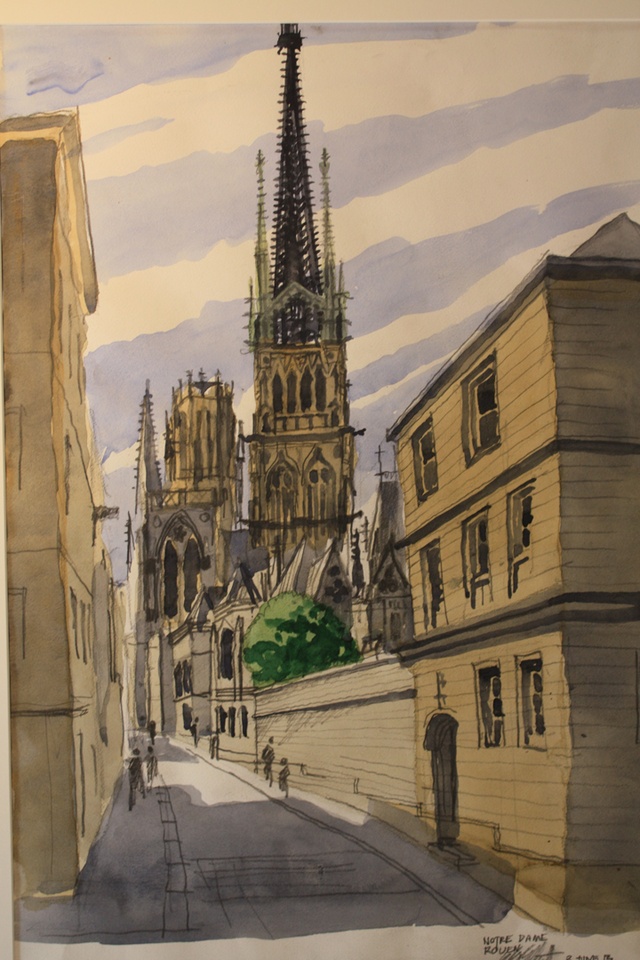
- Seen within its urban context in the magnificent river city of Rouen in northern France. Looking from the back towards the apse.
- Built from the 12th century to 17th. This cathedral has a mix of towers and additions over the centuries but its tight relationship to its urban context makes it special, as seen in the viewpoint chosen.
- This watercolour took 3.5 hours sitting in a shaded spot in a back street.
Amiens Cathedral
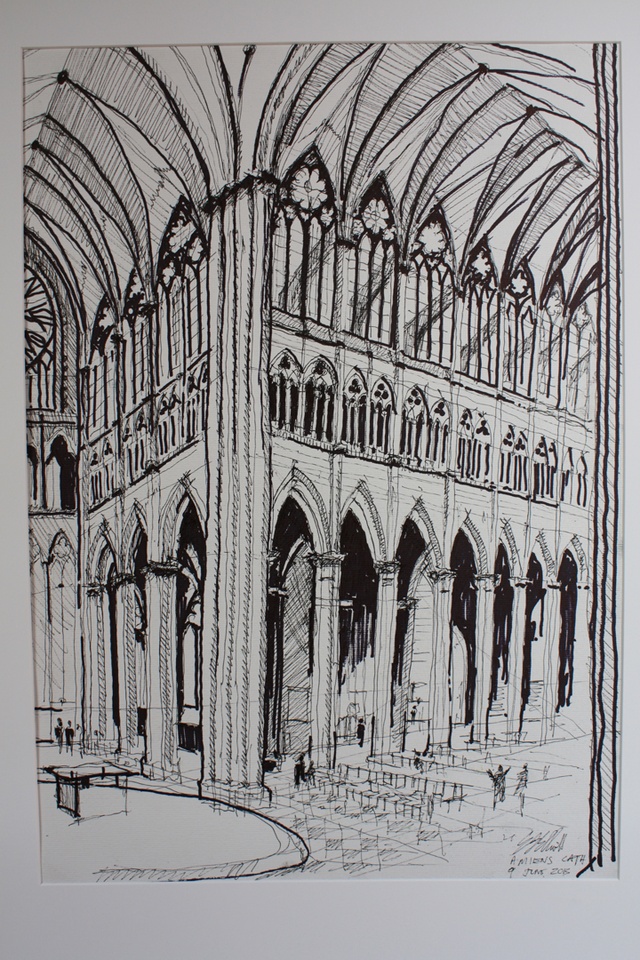
- Amiens is on the banks of the river Somme, in northern France.
- A felt pen and sharpie rendering inside the transept of main nave.
- This sketch took 30mins.
- The scale was captured in this rendering.
- Transept column bulging and cracks in ceiling faults are visible.
Notre Dame Cathedral, Paris
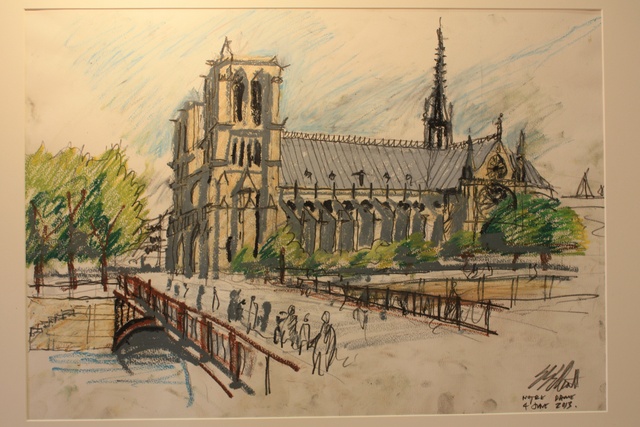
- A pastel and 6 b pencil rendering.
- Took 0.75 hr.
- Captures the movement and the island setting in early summer.
How long do your drawing/paintings normally take?
If it’s a pastel, pencil or felt pen it’s from 15 mins to 2 hours. If watercolour it takes from .75 hours to 9 hours depending on complexity.
Is this your typical medium? And what kind of paper/sketch book do you use?
My usual medium is pastel, watercolour, 6b pencil or felt pen. The paper I use is large format but heavy, good quality watercolour paper in a pad. This heavy duty paper doesn’t need stretching and is very stable while drawing in any location at the sites.
Why do you enjoy drawing while traveling? And what have you learnt though your investigations over time or give an example?
I enjoy drawing while travelling, as it is the only way to really get to know the subject matter and spaces, but also to get to meet the locals. One learns in the process what the building and spaces are really made of. One learns all the geometry and while drawing, the interaction with passersby gives one a further drive. I have met many architects this way. The ability to be able to draw in France is truly encouraged and celebrated by passers-by. There was much discourse and people were amazed I was from New Zealand and doing the paintings.
ERICA KENNY
These drawings are from a sketchbook I took on the 5 week Iberian study tour earlier in the year with 80 students and staff from the Architecture School at Auckland University.
Where was this drawing/sketch made and who is the architect, if applicable? Why did you choose this site to explore?
Patio de las Muñecas (Patio of the Dolls), Palacio Mudéjar de Pedro I El Cruel (Palace of Peter the Cruel), Alcazar de Sevilla, Spain
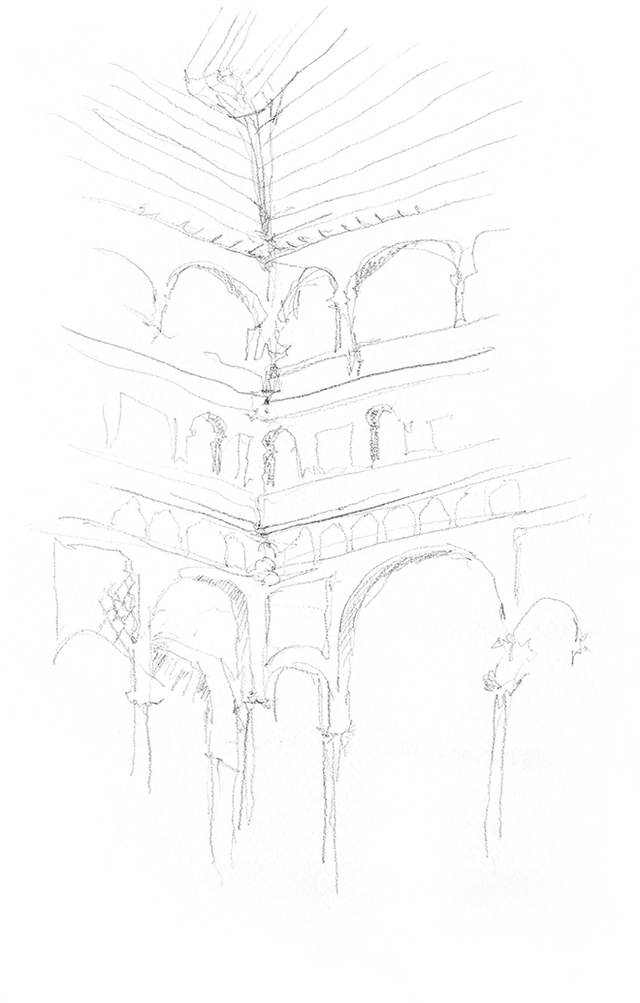
- 14th Century Moorish.
- The detail in the Alcazar is so overwhelming and the layering of the arches is so complex. I was trying to understand how the space is put together and how the intensity of the carved details is balanced by the openings.
Castelo de Trancoso, Trancoso, Portugal
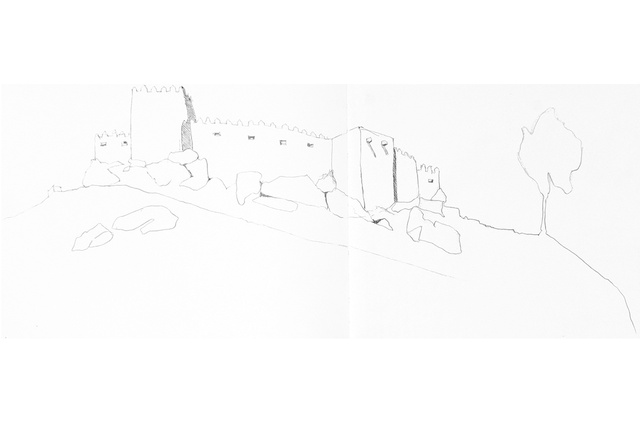
- Pre-1000AD, with contemporary interventions in the interior by Gonçalo Byrne in 2005.
- The sculptural quality of the castle was really appealing, the way it was anchored into the boulders beneath it. The walls were really weighty but they wrapped up and over the boulders so beautifully. The walls were made out of the same stone as they sat on so there was this nice moment where the clean geometry of the walls gave way to the natural form of the rock.
Pavilhão de Portugal (Portuguese National Pavilion), Lisbon, Portugal
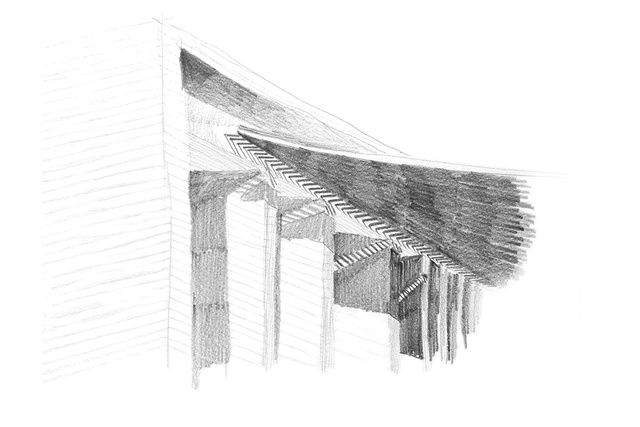
- Built for the 1998 World Expo by Álvaro Siza, Eduardo Souto de Moura and Cecil Balmond.
- I’d seen images of this pavilion in publications but the huge scale of it, the clean lines and deep recesses were more exaggerated than I expected. The quality of the light and the crisp shadows made it look like a model but as I got closer this layer of richness came into focus which I wasn’t expecting, the steel reinforcing detail emerging at each end of the canopy and the brightly-coloured mosaics lining the recesses.
How long do your drawings/sketches/paintings normally take to produce?
Ideally I’d spend 5-10 minutes on an initial drawing, and more time just looking or exploring material details and sketching other design ideas that the initial drawing has sparked. It’s easy to overwork sketches and I get sick of them as soon as they’re done, so the time pressure of a tour like the Iberia one was helpful, it forces you not to be precious, to just draw an immediate response and to capture the key lines or architectural moves quickly.
Is this your typical medium? And what kind of paper/sketchbook?
I like the simplicity of pencil on paper, exploring mark-making, line weights and smudged or clean lines. Watercolour is great if I have the space/time, and watercolour paper is really nice to draw on too. I like having plenty of space to work with but an A4 sketchbook is about the biggest I can justify carrying around when I’m travelling.
Why do you enjoy drawing while travelling? And what have you learnt through your investigation over time?
It’s rare now to travel somewhere without already being exposed to images of it, so drawing is a good way to look at a place with fresh eyes. With each trip I do, I’m getting better at resisting the temptation to take too many photos. I’m learnt to prioritise drawing instead, for me it has the ability to capture my personal experience of a building/space at that moment; the place has to go through my hand as a kind of translation.
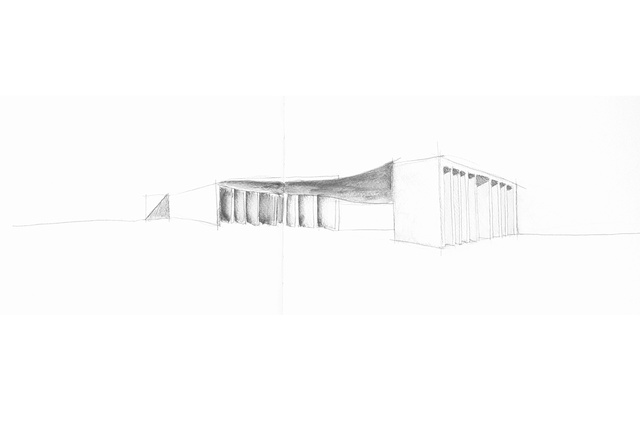
Drawings are nice to reflect on later as I find they bring back stronger memories than my photos do. I get a bit lazy behind a camera, but when I’m drawing I’m forced to slow down for a moment and really look at what’s around me. It’s a great way to learn about architecture. Drawing; making marks to describe the form of a building and organising lines on a page, allows me to discover clues about the logic of the architect and the way they’ve composed a space.
Any interesting feedback from passers-by?
I’ve found that sketching in public while travelling opens up conversation, artists and architects are used to drawing but many people find it quite a novel thing, and will come up and ask questions. On the Iberia trip our huge bus parked up in a small rural town to look at a nursing home designed by Aires Mateus, and 80 of us piled out right next to two women picking vegetables in their dressing gowns.
Initially the women were motioning for us to get lost, but a couple of us sat down quietly with our sketchbooks to draw and one of the women approached us. It turned out she was a landscape architect and was interested to know where we were from and we talked with her about what the building meant to the community. A sketchbook can be a less invasive way to document people and places than a camera, there are photographers who are very skilled at that, but I’m not one of them.
There’s something special about an original drawing too; at the same stop a friend, Lauren, was sketching the building when a resident came up and said to her excitedly “you’re drawing my apartment!”, Lauren gave the woman her drawing and she seemed so happy to have a personal record of the home she was clearly proud of.

